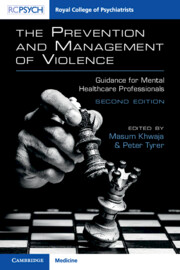Book contents
- The Prevention and Management of Violence
- The Prevention and Management of Violence
- Copyright page
- Dedication
- Contents
- Contributors
- Preface
- Abbreviations
- Section 1 General Aspects of Management
- Section 2 Medical and Psychological Intervention
- Section 3 Violence in Different Settings
- Section 4 Management in Other Groups
- Introduction to Section 4
- Chapter 13 Working With Violence in Children: A Developmental and Relational Perspective
- Chapter 14 Management of Violence in Older Adults
- Chapter 15 Management of Violence in People With Intellectual Disability
- Chapter 16 The Relationship Between Violence and Mental Health Inequality in the Black, Asian and Minority Ethnic Communities
- Section 5 Violence and Society
- Section 6 Engagement and Understanding
- Index
- References
Chapter 15 - Management of Violence in People With Intellectual Disability
from Section 4 - Management in Other Groups
Published online by Cambridge University Press: 09 May 2023
- The Prevention and Management of Violence
- The Prevention and Management of Violence
- Copyright page
- Dedication
- Contents
- Contributors
- Preface
- Abbreviations
- Section 1 General Aspects of Management
- Section 2 Medical and Psychological Intervention
- Section 3 Violence in Different Settings
- Section 4 Management in Other Groups
- Introduction to Section 4
- Chapter 13 Working With Violence in Children: A Developmental and Relational Perspective
- Chapter 14 Management of Violence in Older Adults
- Chapter 15 Management of Violence in People With Intellectual Disability
- Chapter 16 The Relationship Between Violence and Mental Health Inequality in the Black, Asian and Minority Ethnic Communities
- Section 5 Violence and Society
- Section 6 Engagement and Understanding
- Index
- References
Summary
Violent behaviour displayed by individuals with intellectual disability (ID) is one of the biggest challenges to services. It can cause serious consequences to the health and well-being of the individual and those involved in their care, including exclusion from services or social groups. There is a greater risk of violence in the ID population and aetiological causes include biological and psychosocial factors and developmental disorders such as ASD and ADHD. Key management strategies involve a review of these factors, robust risk assessments and collaborative working utilising a multidisciplinary approach. Psychological and behavioural support interventions offered should be person-centred and tailored according to their needs. The goal is to assess and modify psychological, environmental or social factors and improve challenging behaviour. Pharmacological treatment can be helpful where underlying physical or mental health illnesses contribute to aggression. In those without obvious causes of violent behaviour, psychotropic medication can be also used to attenuate risks; however, current evidence base is limited and medication options should be considered on a case-by-case basis.
Keywords
- Type
- Chapter
- Information
- The Prevention and Management of ViolenceGuidance for Mental Healthcare Professionals, pp. 248 - 259Publisher: Cambridge University PressPrint publication year: 2023



